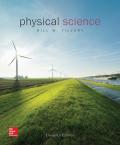
EBK PHYSICAL SCIENCE
11th Edition
ISBN: 8220103146722
Author: Tillery
Publisher: YUZU
expand_more
expand_more
format_list_bulleted
Concept explainers
Question
Chapter 10, Problem 25AC
To determine
The class of given
a. Combination.
b. Ion exchange.
c. Replacement.
d. None of the above is correct because the reaction is incomplete.
Expert Solution & Answer
Want to see the full answer?
Check out a sample textbook solution
Students have asked these similar questions
The drawing shows a crystalline slab (refractive index 1.995) with a rectangular cross
section. A ray of light strikes the slab at an incident angle of 01 = 35.0°, enters the slab,
and travels to point P. This slab is surrounded by a fluid with a refractive index n. What is
the maximum value of n such that total internal reflection occurs at point P?
Ме
Bu
What is the amount of M112 needed to breach a 5-foot thick dense concrete wall utilizing an internal charge placed in the center of the target?
A small postage stamp is placed in front of a concave mirror (radius = 1.1 m), such that the
image distance equals the object distance. (a) What is the object distance? (b) What is the
magnification of the mirror (with the proper sign)?
Chapter 10 Solutions
EBK PHYSICAL SCIENCE
Ch. 10 - Prob. 1ACCh. 10 - Prob. 2ACCh. 10 - Prob. 3ACCh. 10 - Prob. 4ACCh. 10 - Prob. 5ACCh. 10 - Prob. 6ACCh. 10 - Prob. 7ACCh. 10 - Prob. 8ACCh. 10 - Prob. 9ACCh. 10 - Prob. 10AC
Ch. 10 - Prob. 11ACCh. 10 - Prob. 12ACCh. 10 - Prob. 13ACCh. 10 - Prob. 14ACCh. 10 - Prob. 15ACCh. 10 - Prob. 16ACCh. 10 - Prob. 17ACCh. 10 - Prob. 18ACCh. 10 - Prob. 19ACCh. 10 - Prob. 20ACCh. 10 - Prob. 21ACCh. 10 - Prob. 22ACCh. 10 - Prob. 23ACCh. 10 - Prob. 24ACCh. 10 - Prob. 25ACCh. 10 - Prob. 26ACCh. 10 - Prob. 27ACCh. 10 - Prob. 28ACCh. 10 - Prob. 29ACCh. 10 - Prob. 30ACCh. 10 - Prob. 31ACCh. 10 - Prob. 32ACCh. 10 - Prob. 33ACCh. 10 - Prob. 34ACCh. 10 - Prob. 35ACCh. 10 - Prob. 36ACCh. 10 - Prob. 37ACCh. 10 - Prob. 38ACCh. 10 - Prob. 39ACCh. 10 - Prob. 40ACCh. 10 - Prob. 41ACCh. 10 - Prob. 43ACCh. 10 - Prob. 44ACCh. 10 - Prob. 45ACCh. 10 - Prob. 46ACCh. 10 - Prob. 47ACCh. 10 - Prob. 48ACCh. 10 - Prob. 49ACCh. 10 - Prob. 1QFTCh. 10 - Prob. 2QFTCh. 10 - Prob. 3QFTCh. 10 - Prob. 4QFTCh. 10 - Prob. 5QFTCh. 10 - Prob. 6QFTCh. 10 - Prob. 7QFTCh. 10 - Prob. 8QFTCh. 10 - Prob. 9QFTCh. 10 - Prob. 10QFTCh. 10 - Prob. 11QFTCh. 10 - Prob. 12QFTCh. 10 - Prob. 1FFACh. 10 - Prob. 2FFACh. 10 - Prob. 3FFACh. 10 - Prob. 4FFACh. 10 - Prob. 1IICh. 10 - Prob. 1PEBCh. 10 - Prob. 2PEBCh. 10 - Prob. 3PEBCh. 10 - Prob. 4PEBCh. 10 - Prob. 5PEBCh. 10 - Prob. 6PEBCh. 10 - Prob. 7PEBCh. 10 - Prob. 8PEBCh. 10 - Prob. 9PEBCh. 10 -
10. Iron(III) oxide, or hematite, is one mineral...
Knowledge Booster
Learn more about
Need a deep-dive on the concept behind this application? Look no further. Learn more about this topic, physics and related others by exploring similar questions and additional content below.Similar questions
- Calculate the anti-clockwise torque and the clockwise torque of the system with the ruler and the washers. Record these values in Data Table 5. Ruler = 11.56 g, small washer = 1.85 g, large washer = 24.30 g. Calculate the % Difference in the Torques and record the values in Data Table 5. Is ΣAnticlockwise torque and Anticlockwise torque the same thing, are they solved in the same way?arrow_forwardA window washer stands on a uniform plank of mass M = 142 kg and length l = 2.80 m supported by 2 ropes attached at the ends of the plank. The window washer has a mass m = 68.0 kg. What is the tension in each of the ropes, T1 and T2, if the window washer's displacement from the center of mass of the plank is x = 0.930 m as shown in Figure 1: Window Washer Problem?arrow_forwardA man holds a double-sided spherical mirror so that he is looking directly into its convex surface, 33 cm from his face. The magnification of the image of his face is +0.17. What will be the image distance when he reverses the mirror (looking into its concave surface), maintaining the same distance between the mirror and his face? Be sure to include the algebraic sign (+ or -) with your answer.arrow_forward
- How do you draw a diagram of the ruler and mass system in equilibrium identifying the anti-clockwise torque and clockwise torque? How do I calculate the anti-clockwise torque and the clockwise torque of the system with the ruler and the washers, does it come from the data in table 4? Please help, thank you!arrow_forwardExample Double pane windows have two panes of glass (n = 1.5), with a layer of air sandwiched between them. If light from outside enters the first pane at an angle of 25° from the surface normal, what angle does it enter the house at? ☑ 3 5arrow_forwardDid your experiment results in Data Table 3 verify, to within a reasonable experimental error, the condition of equilibrium of Equation 6: Στanti-clockwise = Στclockwise? Support your response with experimental data. What does this Σ mean? My results do not show they are equal to each other, what does this mean then, and what does the data show? Thanks!arrow_forward
arrow_back_ios
SEE MORE QUESTIONS
arrow_forward_ios
Recommended textbooks for you
 An Introduction to Physical SciencePhysicsISBN:9781305079137Author:James Shipman, Jerry D. Wilson, Charles A. Higgins, Omar TorresPublisher:Cengage Learning
An Introduction to Physical SciencePhysicsISBN:9781305079137Author:James Shipman, Jerry D. Wilson, Charles A. Higgins, Omar TorresPublisher:Cengage Learning

An Introduction to Physical Science
Physics
ISBN:9781305079137
Author:James Shipman, Jerry D. Wilson, Charles A. Higgins, Omar Torres
Publisher:Cengage Learning
